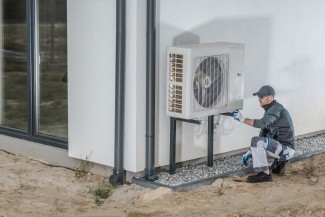Utilities' efficiency programs for customers used to focus solely on saving the most energy. This year, several states have taken key steps toward transforming them to maximize their impact reducing climate pollution.
As the world may have experienced our hottest days in recorded history in July, the imperative to do everything possible to reduce planet-warming pollution has never been greater. Energy efficiency programs have helped significantly but aren’t yet doing what they can and must when it comes to cutting pollution. This year, though, has seen very encouraging developments: states that collectively have more than a quarter of the U.S. population have taken steps to begin to transform these programs to take on the challenge.
Revamping utility efficiency programs—as set out in ACEEE reports The Need for Climate-Forward Efficiency and A Roadmap for Climate-Forward Efficiency—means shifting from a focus on maximizing energy savings to a focus on cutting greenhouse gas emissions, while also keeping an eye on energy savings. State legislatures and utility regulators have a key role in enabling that transition to happen. Here’s how several have recently stepped up.
Utility regulators in California—perennially the nation’s leader on energy efficiency— in April adopted a framework for shifting energy efficiency programs to focus on supporting electric appliances and improving building envelopes and to phase out incentives for gas appliances. That transition is a key recommendation from recent ACEEE research on efficiency’s role in a high renewable energy future and the importance of weatherization as a key foundation for electrification. California regulators also finalized more than $1 billion annually for new efficiency program budgets for 2024–2027.
Similarly, utility regulators in Colorado finalized a decision in June to phase out incentives for gas appliances and increase efficiency and electrification program budgets through 2026. New Jersey regulators laid out their own plans for efficiency and electrification with proposals in June focused on replacing systems that use delivered fuels such as propane and oil to heat homes. And this month New York regulators exceeded California’s leadership by also ordering $1 billion annually in efficiency and electrification plans (for context, New York’s population is about half of California’s) for the 2026-2030 time period as part of the state’s ambitious plan for aligning energy efficiency programs with climate protection commitments, the “New Efficiency: New York” initiative. New York regulators ordered 85% of that funding be used for electrification and envelope improvements and specifically prohibited additional funding after 2025 for gas-burning appliances.
Even the nation’s largest program to encourage households to buy energy-efficient appliances, the Environmental Protection Agency’s ENERGY STAR®, got into the act, proposing to phase out certification of one-way (non-heat pump) air conditioners, furnaces, and boilers in favor of heat pumps, which are far more efficient. These actions—increasing efficiency budgets and shifting incentives from fossil fuel-burning appliances to efficient electric versions—are the kind of transformations necessary for the future of an energy-efficient economy.
While these actions represent the leading edge of progress, there are initial steps states are making, too. Before California proposed and finalized a new framework this year, utility regulators first established a “total system benefit” metric for evaluating efficiency programs. Whereas traditional efficiency cost-effectiveness tests just look at energy system costs, or even more limited ratepayer cost impacts, the “total system benefit” incorporates energy, capacity, and climate pollution reduction benefits for a more accurate value of energy efficiency. After years of development, utility regulators in Minnesota followed suit and adopted a “Minnesota Cost Test” in March that incorporates the impact of climate pollution and will apply to the state’s energy efficiency programs for 2024–2026.
After all this progress, what’s coming next? Maryland regulators will also make decisions this year on how new efficiency programs for 2024–2026 will take the state’s climate pollution reduction commitments into account. One of the most exciting developments could be in Michigan, where legislators have introduced a bill to set energy efficiency targets of at least 2% of annual energy sales, which is consistent with the performance of leading states and Michigan’s climate protection goals.
While these actions demonstrate states are recognizing energy efficiency’s critical role in avoiding the worst impacts of climate disruption, helping reduce costs for energy-burdened and underserved households and communities is an equally important mission for energy efficiency. In a future post, I’ll highlight some of the tremendous progress made in several states so far this year to lower energy burdens through energy efficiency and utility regulation.


